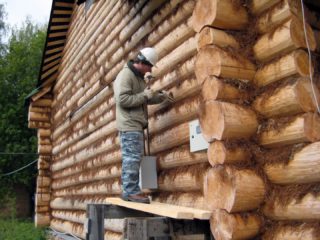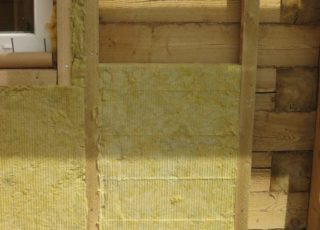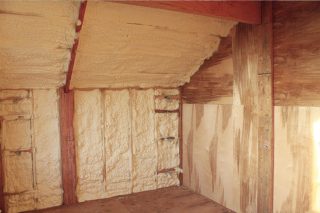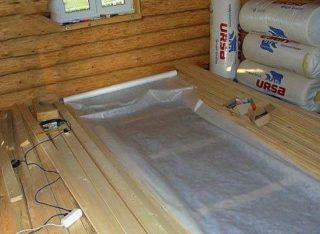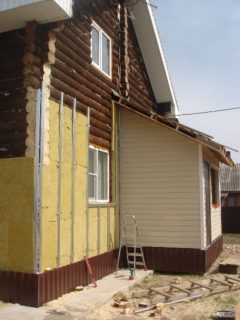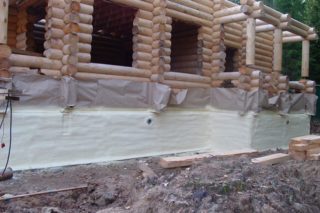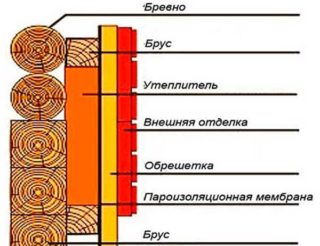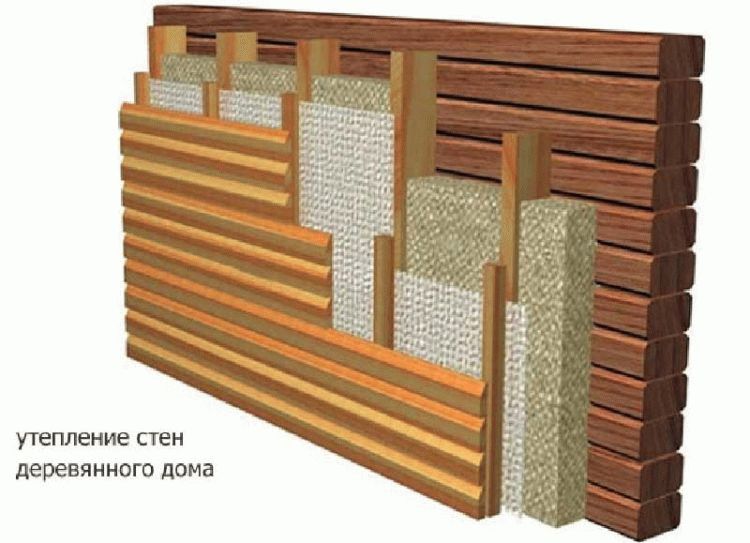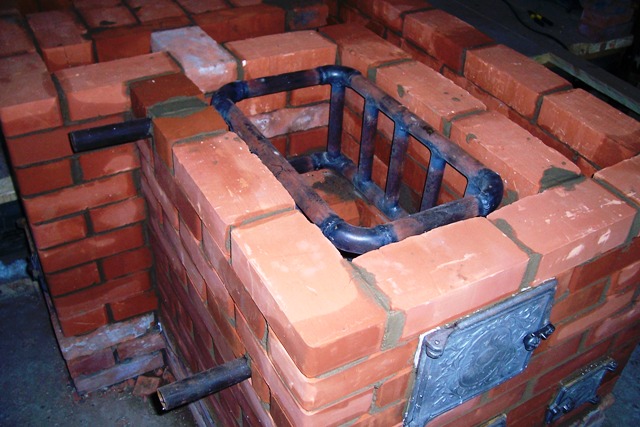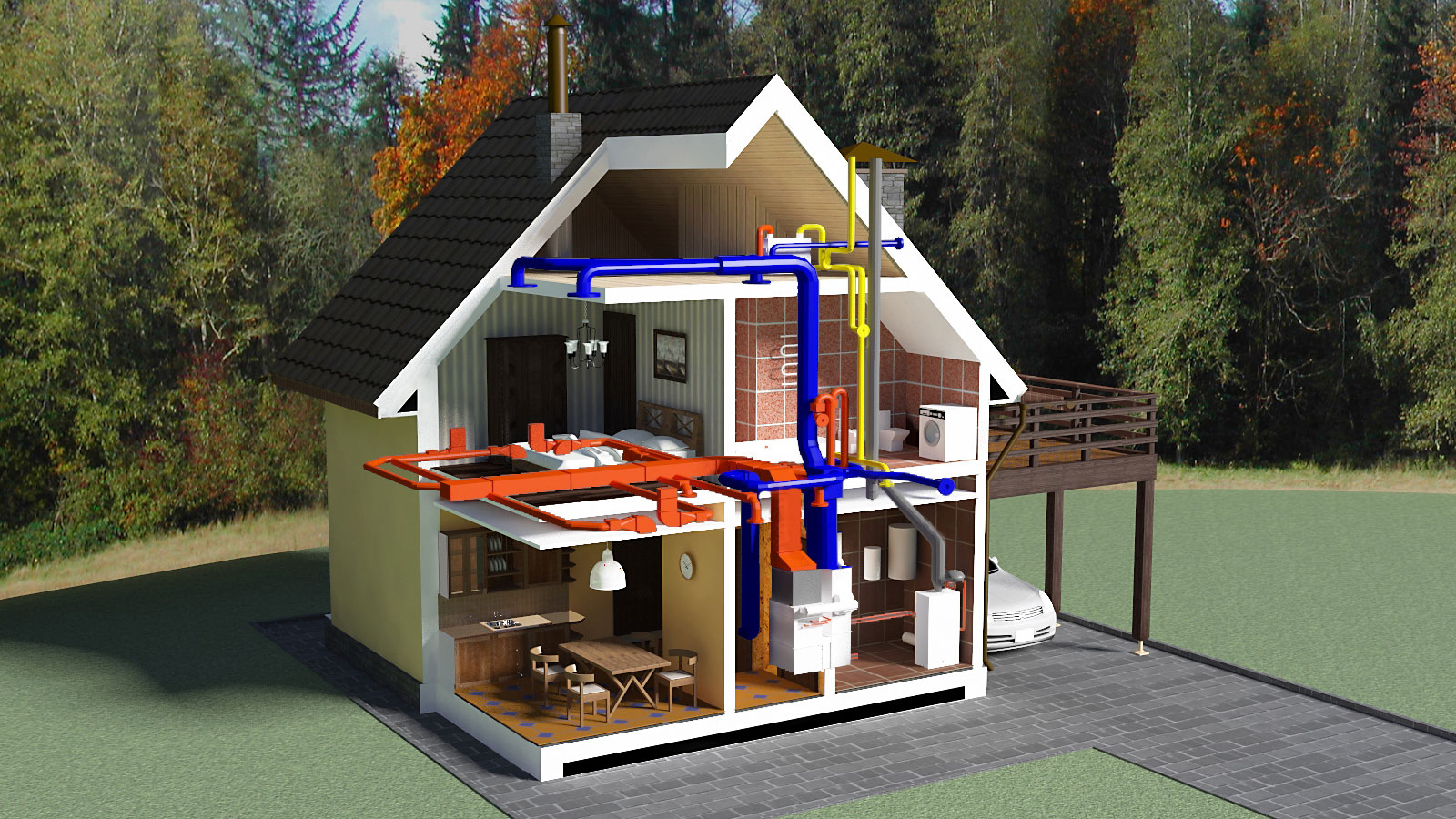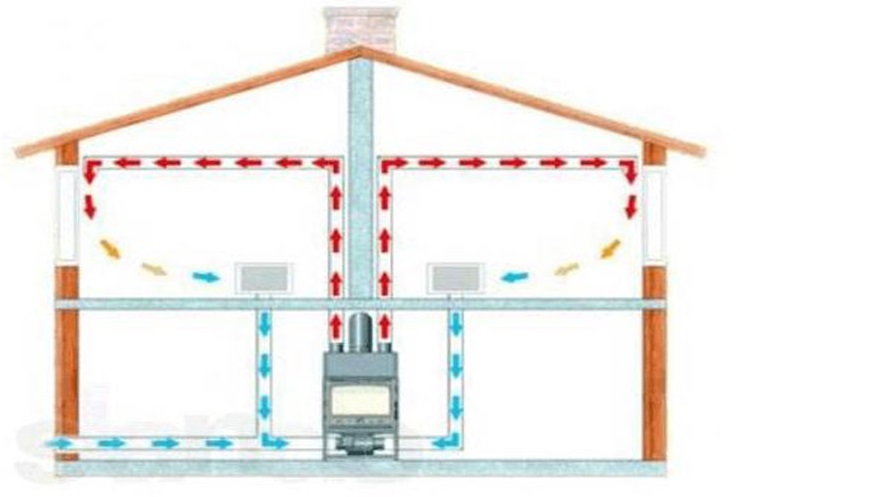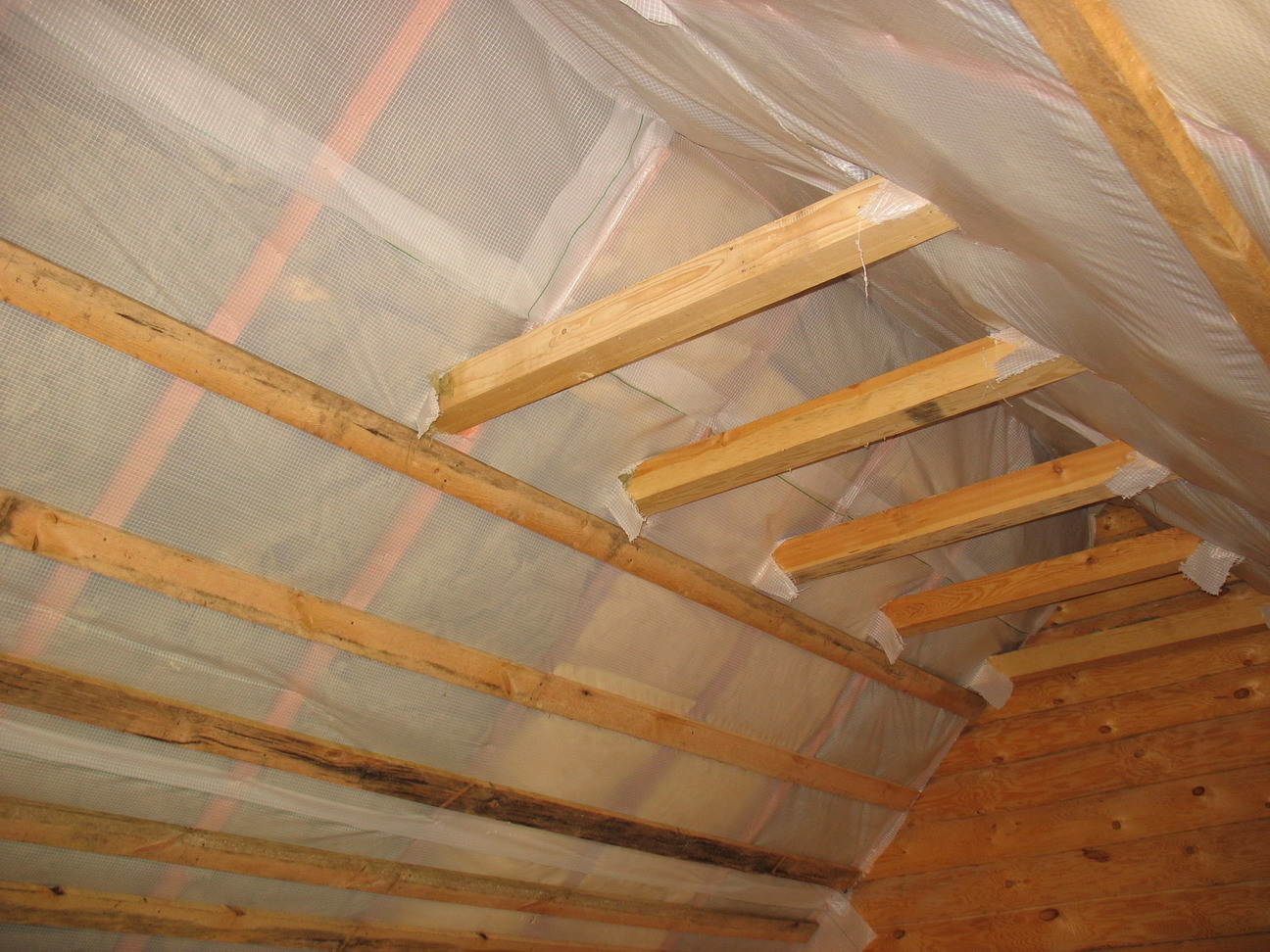Log houses attract with their environmental friendliness, the ability to retain warm air, creating a favorable climate for living. Practice has proven that a wall of logs 0.24 m thick in terms of thermal conductivity is comparable to a brickwork of 1 m. But in such dwellings it can also be cold and uncomfortable.
Insulation of a log house is necessary if drafts suddenly appear, it pulls cold on the legs, the house cools down quickly in winter when the heating is turned off. Why is this happening? There are several reasons. Perhaps the building was built with some deviations from the technology or the building is old and needs restoration. There are many more reasons why a structure can be cold. There is only one result: it is urgent to start thermal insulation, otherwise, with the onset of cold weather, it will be, to put it mildly, uncomfortable to live in it.
Preparation for work, material, tools
- To install the frame - wooden blocks, the width of which is equal to the width of the selected insulation;
- Heat insulating material;
- Hydro barrier;
- Sheathing materials of the log building outside;
- Fasteners;
- Construction knife, tape measure, level;
- Hammer, nails, nail puller, wood saw.
What materials to choose
What is recommended to insulate a log building:
- Straw, cellulose wool, wood shavings, algae, mineral wool are ideal for arranging the attic;
- It is worth digging the walls with tow, moss, jute, any tape insulation based on linen or jute threads;
- After caulking, the house is insulated from the outside using mineral wool and other "breathing" materials.
Insulation of walls with expanded clay allows you to ensure the comfort of living. It has excellent thermal insulation characteristics, while being strong and durable.
If the floor in the room is concrete, sheets of dense basalt wool, foam or cork are suitable for thermal insulation. When the floor is wooden on logs, it is recommended to carry out thermal insulation of rolled mineral wool, filled with natural materials.
Insulation of an old or new building should be carried out in compliance with the technology. Particular attention is paid to the choice of heat-insulating materials, which must have the following characteristics:
- Air and vapor permeability on a par with the log walls of the dwelling. This quality is especially important for heaters intended for outside wall cladding;
- Wall insulation outside and inside is carried out using moisture-resistant materials, otherwise the accumulation of steam on the surfaces will cause rotting of the wood, the appearance of mold;
- To be fireproof, at the same time loose, because their task is to adhere tightly to the walls so that there are no voids left between the material and the embossed log surface.
The works include a number of measures to ensure the most comfortable living. To do this, you need to close up the gaps in window openings, the gaps of door frames, insulate the walls, ceiling, roof and floor.
Ceiling and roof
Thermal insulation of the ceiling of a log house is a mandatory process. First, the attic is lined with waterproofing, insulation with a thickness of about 0.25 m is laid on top.If the building is equipped with an attic, it is worth insulating the interfloor overlap. The inner surface of the roof is also lined with a waterproofing film, then mineral wool with a sheet width of 5-10 cm is placed, and the top is covered with a membrane material.
Thermal insulation of walls
Thoroughly pierce the surfaces, properly seal the door spans, window frames with mineral wool, insulation for the inter-crown slots. It is not worth blowing out the cracks with polyurethane foam. The walls of log buildings are unstable, dynamic, and foam is non-plastic. Over time, it will deform and lose functionality.
To insulate the walls of the house, you can also sheathe it with wooden clapboard. To do this, first mark the walls, then build a frame using metal profiles. After that, the insulation is laid using mineral wool or foam sheets.
The heat-insulating material is fixed with screws or dowels with wide caps, and covered with a waterproofing film on top. On the crate, it can be fixed with double-sided or aluminum tape, at the end, sheathe the walls with plasterboard or clapboard.
There is another way to insulate the walls of a log structure, but it can only be used if the dwelling is heated. First, the surfaces are cleaned, removing the plaster left over from the previous repair. After that, a frame made of reinforcement is installed, on top - a metal mesh with 5 cm cells. Then they proceed to plastering the surfaces, while applying several layers of plaster. The liquid composition is applied first to the walls, the second layer is a primer, thicker, hiding surface defects as much as possible. Final treatment - application of a thin layer of plaster, which is later covered with paint, pasted over with wallpaper.
How to insulate the floor
If the floor is lined with wood, first the voids between the logs are filled with insulation 10-15 cm thick, a rough floor is lined on top, then a final floor.
The concrete floor, or rather the gap between the main and the "thin" concrete layer, is filled with 5-8 cm thick sheet of foam plastic, after which the finishing is started.
It is also possible to insulate the floor using the ventilated facade technology, having equipped a "warm floor" before that.
External thermal insulation
External insulation in a log house should be carried out no earlier than 1.5-2 years after the construction of the building. During this time, it will "sit down", the premises inside will be ready for further insulation. The best option for building thermal insulation is the arrangement of a ventilated facade with free air circulation.
First, they carefully examine the walls, sealing cracks and voids. Work is carried out when it is dry and warm outside the window. To seal the cracks, they are carefully filled with insulation until they stop, wielding a special spatula. After sealing the cracks, they proceed to the wall cladding outside for siding.
Insulation for siding
You can strengthen the vapor barrier around the edges with tape, then shoot it with a construction stapler or nail it down.
Making the frame is the next step. First, the crate is stuffed, observing a step equal to the width of the insulation. For work, wooden beams 100 mm wide, about 45 mm thick, which are nailed to the surface, are ideal. Then, with layers of heat-insulating material, the voids between the guides are filled. Plates are laid tightly to each other, trying to keep as few gaps as possible between them. Sheets of elastic mineral wool with a density of 80 to 120 kg / m3 will be a good insulating material. It fits perfectly inside the lathing, it is easily held between the bars without the need for fastening.
When the insulation is installed, the walls are lined with a waterproofing membrane that provides optimal wind protection. This is an important point in the thermal insulation of a building, because on the one hand, it must let steam through, on the other, it must additionally retain it. The film is attached to the crate with a stapler or nails. Docking seams are overlapped, sealed with tape, shot with a stapler or nailed.
Final finishing after installing the battens, insulation - wall cladding with siding, clapboard, plastic panels.
Insulation of the facade of a log house can be done independently, but if there is no experience in such work, it is better to trust the professionals.
How to insulate the foundation
Polystyrene plates are ideal for insulation. First, a trench is dug along the perimeter of the building, reaching deep to the base. If there is a sand and gravel pillow under the house, the first layer of insulation is mounted on it. If there is no pillow, it is worth pouring about 0.1 m of sand mixed with gravel on the bottom of the trench, and then proceed directly to pasting the foundation with polystyrene plates. They are seated on special glue without organic components, first smearing the vertical surface of the foundation with mastic, gluing the plates in a dotted manner. After laying, the joints are sealed by treating with an adhesive.
Liquid polyurethane foam can also be used to reliably protect the foundation from moisture, to provide heat in the house. The components of the composition are mixed in a special apparatus, then applied to the surface. Liquid polyurethane foam hardens after 20 minutes, forming a monolithic coating that reliably protects the foundation.
Practicing Masters Tips
When working with glass wool or mineral wool, you should be careful, you must use personal protective equipment - a respirator, gloves.
If for the organization of insulation there is a choice between foam and mineral wool, the latter should be preferred. The material is more practical, it will not be spoiled by rodents, insect pests.
Log walls should be treated with anti-fungal compounds, which will increase the durability of the building.
It is advisable to carry out thermal insulation in dry weather, for which the summer season is ideal.
If it is decided to use roofing material as waterproofing, it should not be strengthened with umbrella dowels. They will damage the material, moisture will penetrate through the holes.
Possible problems and solutions
With external wall insulation, it is worthwhile to carry out high-quality waterproofing before installing the 2nd lathing. It is laid, secured with metal staples, shot with a construction stapler, or nailed. At the same time, the seams overlap with a width of about 5-10 cm.
The joints are carefully sealed with a self-adhesive sealing tape made of foamed polyethylene with a foil-clad copper layer.
After installing the 2nd lathing, the area below should be lined with a metal mesh with small cells. This will protect the walls from the invasion of rodents, wood-boring pests.
Insulation outside for siding, clapboard cladding, panels should be carried out after carefully sealing the cracks of window and door frames. For this, a sealant is used, paying special attention to the window sills.
Home insulation is beneficial for many reasons. Firstly, this will save up to 40% of the family budget on heating the premises, which is especially important with the constant rise in the price of energy resources. Secondly, living in a warm home is a guarantee of the health of the inhabitants, which is especially important if the family lives with children.

